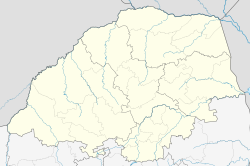
Artifacts indicating human activity dating back to the early Stone Age have been found in the Kingdom of Eswatini. The earliest known inhabitants of the region were Khoisan hunter-gatherers. Later, the population became predominantly Nguni during and after the great Bantu migrations. People speaking languages ancestral to the current Sotho and Nguni languages began settling no later than the 11th century. The country now derives its name from a later king named Mswati II. Mswati II was the greatest of the fighting kings of Eswatini, and he greatly extended the area of the country to twice its current size. The people of Eswatini largely belong to a number of clans that can be categorized as Emakhandzambili, Bemdzabu, and Emafikamuva, depending on when and how they settled in Eswatini.
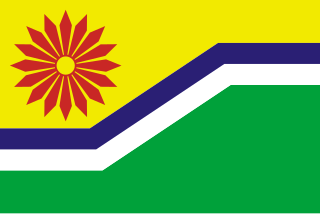
Mpumalanga is one of the nine provinces of South Africa. The name means "East", or literally "The Place Where the Sun Rises" in the Nguni languages. Mpumalanga lies in eastern South Africa, bordering Eswatini and Mozambique. It shares borders with the South African provinces of Limpopo to the north, Gauteng to the west, the Free State to the southwest, and KwaZulu-Natal to the south. The capital is Mbombela.
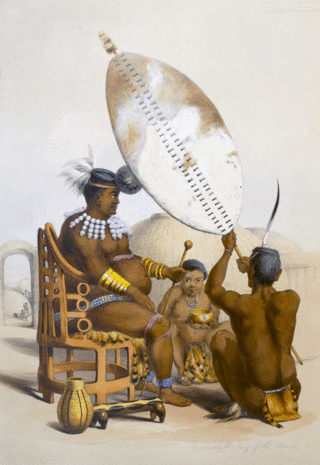
Mpande kaSenzangakhona was monarch of the Zulu Kingdom from 1840 to 1872. He was a half-brother of Sigujana, Shaka and Dingane, who preceded him as Zulu kings. He came to power after he had overthrown Dingane in 1840.

The Swazi or Swati are a Bantu ethnic group native to Southern Africa, inhabiting Eswatini, a sovereign kingdom in Southern Africa, and South Africa's Mpumalanga province. EmaSwati are part of the Nguni-language speaking peoples whose origins can be traced through archaeology to East Africa where similar traditions, beliefs and cultural practices are found.
Ngwane V was the King of Swaziland from 1895 until his death on 10 December 1899. Ngwane was born the son of Mbandzeni and his mother was Labotsibeni Mdluli. He ascended to the throne after a short regency of Queen Mother Tibati Nkambule. He was only 16 years old when he became king. His royal capital was at Zombodze while the Queen Mother's residence was at Lobamba.
King Mswati II, also known as Mswati and Mavuso III, was the king of Eswatini between 1840 and 1868. He was also the eponym of Eswatini. Mswati is considered to be one of the greatest fighting kings of Eswatini.
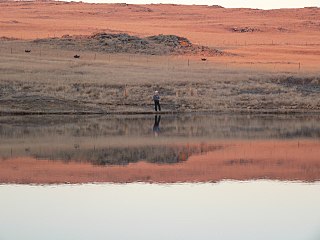
Dullstroom, also known as Emnothweni, is a small town in Mpumalanga province, South Africa. The town lies 35 kilometres north of Belfast and some 53 kilometres south-west of Lydenburg on the R540 road.

Hazyview is a sub-tropical farming town in Mpumalanga, South Africa, renowned for its large banana and macadamia nut industries, contributing about 20% of South Africa's bananas and 30% of macadamia output. Bordering the Kruger National Park, the town's name is derived from the shimmering haze that occurs during the heat of summer. Most of the province of Mpumalanga's private game reserves are found just east of Hazyview.

Komatipoort is a town situated at the confluence of the Crocodile and Komati Rivers in Mpumalanga province, South Africa. The town is 8 km from the Crocodile Bridge Gate into the Kruger National Park, just 5 km from the Mozambique border and 65 km from the Eswatini border.
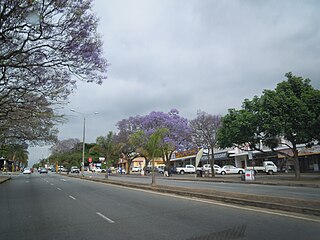
White River is a small holiday and farming town situated just north of Mbombela in Mpumalanga, South Africa. The farms in the region produce tropical fruits, macadamia nuts, vegetables, flowers and timber. As of 2011, White River had a population of 16,639.
The Lobedu or Balobedu(also known as the BaLozwi or Bathobolo) are a southern African ethnic group that speak a Northern Sotho dialect. Their area is called Bolobedu. The name "balobedu" means "the mineral miners," lobela or go loba, - to mine. Their ancestors were part of the great Mapungubwe early civilization. They have their own kingdom, the Balobedu Kingdom, within the Limpopo Province of South Africa with a female ruler, the Rain Queen Modjadji.
Mbandzeni was the King of Swaziland from 1872 until 1889. Ingwenyama Mbandzeni was the son of Mswati II and Nandzi Nkambule. His mother the wife of King Mswati had died when he was still very young.

The Sudwala Caves in Mpumalanga, South Africa, are set in Precambrian dolomite rock, which was first laid down about 2800 million years ago. The caves themselves formed about 240 million years ago. They are one of the oldest caves in the world.
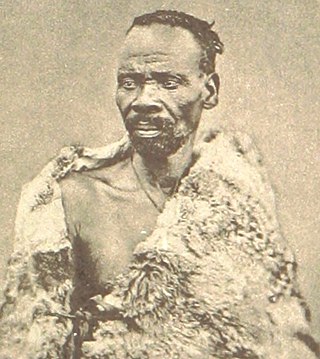
Sekhukhune I was the paramount King of the Marota, more commonly known as the Bapedi, from 21 September 1861 until his assassination on 13 August 1882 by his rival and half-brother, Mampuru II. As the Pedi paramount leader he was faced with political challenges from Voortrekkers, the independent South African Republic, the British Empire, and considerable social change caused by Christian missionaries.
Byldrift is a village community 281 km northeast of Pretoria. Byldrift is an extension and part of Malatane. Both these communities were founded by Seloane, the second son of King Matlebjane II of Batau. Matlebjane II had other sons: Masemola, Phaahla, Mogashoa and Photo. Masemola founded Masemola village, Phaahla founded Phaahla village, and Mogashoa founded Mogashoa village. The people in these villages belong to Batau tribe and consider themselves as one blood and are related through a deep long entrenched social history that is traced from Eswatini.
The Batau clan trace their origin from the Swazi. They moved north to Lake Chrissie area from Wakkerstroom. After the defeat by Mzilikazi during the Mfecane they settled in the area now known as Sekhukhuneland in Limpopo Province. Their totem animal is the lion.
The Pulana, or Mapulana, are a low-veld ethnic group found in Bushbuckridge near Mpumalanga and Limpopo provinces. Their language is called Sepulana and is considered a dialect of the Northern Sotho language group. although it is a northern sotho dialect it also hugely influenced by Xitsonga, Swati, Afrikaans, English, and Setswana
Mampuru II was a king of the Pedi people in southern Africa. Mampuru was a son of the elder brother of Sekwati and claimed he had been designated as his successor.
Sekwati was a 19th-century paramount King of the Maroteng, more commonly known as the Bapedi people. His reign focused on rebuilding the Marota Kingdom at the conclusion of the Mfecane and maintaining peaceful relations with the Boer Voortrekkers and neighboring chiefdoms in the north-eastern Transvaal. He was the father of rivals Sekhukhune I who took over the Marota/Pedi paramountcy by force, and Mampuru II, his rightful successor.
House of Zwide is a South African television drama series. It is an e.tv original production, co-produced by The Bomb Shelter and Videovision Entertainment for e.tv. The series stars Vusi Kunene, Khaya Dladla, Nefisa Mkhabela, and Winnie Ntshaba, among others.
